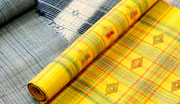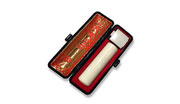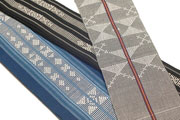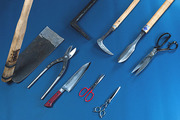Okinawa
- Sort by
- Popularity
- Name
-
Koshu lacquered deer leather Koshu inden
- Other crafts
- Yamanashi

Koshu lacquered deer leather (called Koshu inden in Japanese) is a unique style of leathercraft that was developed in the city of Kofu, Yamanashi prefecture. Koshu lacquered deer leather is unique because of its combination of deer leather and uru…
View more
-
Aizu lacquerware Aizu nuri
- Lacquerware
- Fukushima

Aizu lacquerware (called Aizu nuri in Japanese) is lacquerware made in the Aizu region of Fukushima prefecture. During the manufacturing process, the craft is classified into round pieces, such as bowls, and flat pieces such as trays or stationery…
View more
-
Otani ware Otani yaki
- Ceramic
- Tokushima

Otani ware (called Otani yaki in Japanese) is a form of ceramics that is the most famous product of the city of Naruto in Tokushima prefecture, and is the representative craft for the prefecture. The notable characteristics of Otani ware are its s…
View more
-
Obori-soma ware Obori soma yaki
- Ceramic
- Fukushima

Obori-soma ware (called Obori-soma yaki in Japanese) is a form of porcelain produced around the town of Namie in Fukushima prefecture. This craft uses blue porcelain enamel which is made from locally collected grindstone. The distinctive feature …
View more
-
Tsuboya ware Tsuboya yaki
- Ceramic
- Okinawa

Tsuboya ware (called Tsuboya yaki in Japanese) is a form of pottery produced mainly in Tsuboya, city of Naha, Okinawa prefecture. This craft is one of the leading representations of Okinawan pottery (yachimun in the Okinawa dialect). The notable f…
View more
-
Aizu-hongo ware Aizu hongo yaki
- Ceramic
- Fukushima

Aizu-hongo ware (called Aizu-hongo yaki in Japanese) is a traditional handicraft from the region of Aizu in Fukushima prefecture with a history of about four hundred years. This pottery, which is thought to have originated during the Sengoku perio…
View more
-
Boshu uchiwa fans Boshu uchiwa
- Other crafts
- Chiba

Boshu uchiwa is a type of fan made in the areas around the cities of Tateyama and Minamiboso in Chiba prefecture. This is one of Japan’s big three uchiwa types, with the other two being Marugame (Kagawa prefecture) and Kyo uchiwa (Kyoto prefecture…
View more
-
Miyako ramie textile Miyako jofu
- Woven textiles
- Okinawa

Miyako jofu is a textile produced on the island of Miyakojima, Okinawa prefecture. It is woven from a fabric called ramie and dyed with Ryukyu indigo, a type of indigo native to Okinawa. This textile has a fine kasuri pattern* and a smooth and lu…
View more
-
Ryukyu lacquerware Ryukyu shikki
- Lacquerware
- Okinawa

Ryukyu lacquerware (called Ryukyu shikki in Japanese) is produced in Okinawa prefecture. Lacquerware techniques imported from China were well-adapted during the development of Ryukyu lacquerware unique to Okinawa. The technology and artistry invol…
View more
-
Kumejima tsumugi silk Kumejima tsumugi
- Woven textiles
- Okinawa

Kumejima tsumugi silk is a textile produced on the island of Kumejima, Okinawa prefecture. The history of this craft goes back all the way to the Muromachi period (1336-1573). This textile is distinct because of its elegant texture and deep color …
View more
-
Ryukyu traditional resist-dyed textiles Ryukyu kasuri
- Woven textiles
- Okinawa

Ryukyu kasuri is a textile made in Okinawa prefecture. It is made mostly from silk and dyed with both plant and synthetic dyes using a kasuri* or resist-dyeing technique. This craft features over six hundred different kinds of patterns inspired by…
View more
-
Kishu lacquerware Kishu shikki
- Lacquerware
- Wakayama

Kishu lacquerware, also known as kuroe-nuri, is produced around the Kuro-e region northwest of the city of Kainan, Wakayama prefecture. This craft is simple, durable, and practical and has been popular as a household good since the Edo period (160…
View more
-
Chibana-hanaori textiles Chibana hanaori
- Woven textiles
- Okinawa

Chibana hanaori is a textile produced in Chibana, Okinawa, Okinawa prefecture. It has flowery patterns woven in the base textile as well as a continuous geometric pattern. This kind of textile with a continuous geometric pattern is called mon orim…
View more
-
Kishu bamboo fishing rods Kishu herazao
- Wood, bamboo crafts
- Wakayama

Kishu bamboo fishing rods (called Kishu herazao in Japanese) are produced in the city of Hashimoto, Wakayama prefecture for catching Japanese crucian carp. The bamboos: suzutake, madake, and yadake are cut, left to dry for several years, and only …
View more
-
Yaeyama cotton cloth Yaeyama minsa
- Woven textiles
- Okinawa

Yaeyama minsa is a fabric produced in the town of Taketomi, Yaeyama district and the city of Ishigaki, Okinawa prefecture. The origin of this craft is not clear but it is thought that the kasuri belt was brought to Okinawa from Afghanistan via Chi…
View more
-
Yaeyama ramie cloth Yaeyama jofu
- Woven textiles
- Okinawa

Yaeyama jofu is a fabric produced in the area surrounding Yaeyama ward in Ishigaki city, Okinawa prefecture. This textile is woven with hand-spun ramie threads and used to be produced as a tax to the Ryukyu Kingdom (present day Okinawa) in ancient…
View more
-
Awa traditional Japanese paper Awa washi
- Traditional Japanese paper
- Tokushima

Awa washi is traditional Japanese paper made in Yoshinogawa, Naka-cho, and Ikeda-cho in Tokushima prefecture. It is produced using the traditional papermaking methods of nagashisuki (papermaking in flowing water), and tamesuki (papermaking using s…
View more
-
Shuri brocade Shuri ori
- Woven textiles
- Okinawa

Shuri brocade (called Shuri ori in Japanese) is a woven fabric produced on the main island of Okinawa. There are two types of fabric, kasuri orimono and mon orimono, and these include hanaui, hanakura ori, doton ori, kasuri and minsa. The Ryukyu …
View more
-
Yomitanzan-hanaori textiles Yomitanzan hanaori
- Woven textiles
- Okinawa

Yomitanzan hanaori is a textile produced in the village of Yomitan, Okinawa. The threads of this craft are first dyed before being woven in a geometric, flowerlike design. This craft is woven with silk or cotton threads dyed with plant-based dyes …
View more
-
Koshu crystal and precious stones carving Koshu suisho kiseki zaiku
- Semiprecious stone craftwork
- Yamanashi

Koshu crystal and precious stones carving called Koshu Suisho Kiseki zaiku in Japanese, are crystal and precious gemstone carvings produced in the city of Kofu, Yamanashi prefecture. Using traditional methods, natural gemstones are carefully cut, …
View more
-
Okuaizu Basketry Oku aizu amikumi zaiku
- Wood, bamboo crafts
- Fukushima

Okuaizu Basketry, called Okuaizu Amikumi Zaiku in Japanese, is basketry produced around Mishima Town, Onuma County, Fukushima Prefecture. As this mountainous area in the Okuaizu region has much snow and farmers are unable to work in the fields in …
View more
-
Ryukyu traditional textiles Ryukyu bingata
- Dyed textiles
- Okinawa

Ryukyu Bingata is a dyed and woven textile produced around Shuri, Okinawa prefecture. Its origin goes back to the 14th to 15th century. The ladies of the royal family or the families of the warrior class wore Ryukyu Bingata. There are two kinds of…
View more
-
Awa-shijira cotton cloth Awa shoai shijira ori
- Woven textiles
- Tokushima

Awa Shoai Shijira Ori is a cotton textile produced in Tokushima City, Tokushima Prefecture. Shijira Ori had been produced in Awa since the 18th century, and the Shijira Ori dyed with Awa indigo was referred to as Awa Shoai Shijira Ori. It was desi…
View more
-
Kijoka banana fiber cloth Kijoka no bashofu
- Woven textiles
- Okinawa

Kijoka no Bashofu are a woven cloth produced in Kijoka, Ogimi Village in northern Okinawa. Bashofu is made from the fibers of the Japanese banana plant called Basho, and has been used to make kimonos in Okinawa since ancient times. Kijoka no Basho…
View more
-
Kishu traditional chest Kishu tansu
- Wood, bamboo crafts
- Wakayama

Kishu Tansu are masterpieces of traditional woodwork made in an area around Wakayama City, Wakayama Prefecture. Kishu Tansu are so called because the manufacturing technique was established in Kishu, the current Wakayama Prefecture. As high-qualit…
View more
-
Yonaguni brocade Yonaguni ori
- Woven textiles
- Okinawa

Yonaguni Brocade, called Yonaguni Ori in Japanese, is a textile produced in Yonaguni-cho, Yaeyama Gun, Okinawa Prefecture. The characteristic of Yonaguni Ori is the simple beauty of the textile that is dyed and woven by hand in the distinctive cli…
View more
-
Koshu hand-carved seals Koshu tebori insho
- Other crafts
- Yamanashi

Koshu Tebori Insho are hand-engraved personal signature stamps produced in Kofu City and Fujiyoshida City of Yamanashi Prefecture. Bringing together all of Yamanashi’s engravers, dealers, and material producers, this local industry is unlike those…
View more
-
Yuntanza minsa Yomitanzan minsa
- Woven textiles
- Okinawa

Yuntanza Minsa is a textile produced in the region around Yomitanson, Nakagami-gun, Okinawa prefecture. Min means "cotton" and sa means "narrow belt". Narrow belts were made in various regions in Okinawa from ancient times. Bas…
View more
-
Chiba Artisan Tools Chiba Koshogu
- Metal works
- Chiba

Chiba Artisan Tools are cutlery and hand tools made in the Boso Peninsula of Chiba prefecture, using traditional techniques. Their main products are sickles, hoes, knives and western style scissors. As iron sand was mined in the Boso Peninsula fr…
View more
-
Flower pattern textiles Haebaru hanaori
- Woven textiles
- Okinawa

Haebaru flower patterned textiles called Haebaru Hanaori in Japanese, are made in the city of Haebaru in the Okinawa Prefecture. Plants harvested in the prefecture such as garcinia or Assam indigo are used to dye the yarns. Haebaru Hanaori can be …
View more































































































































































































































































































